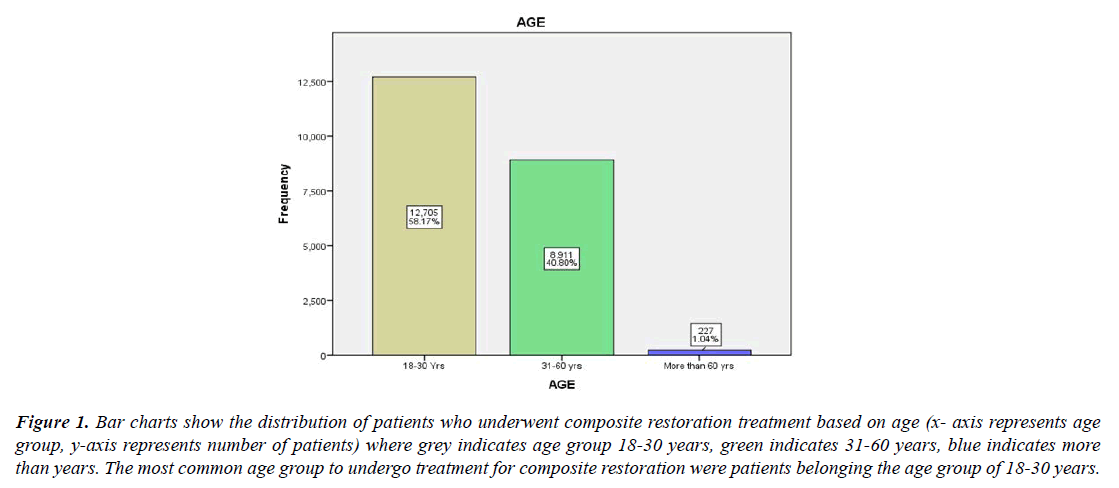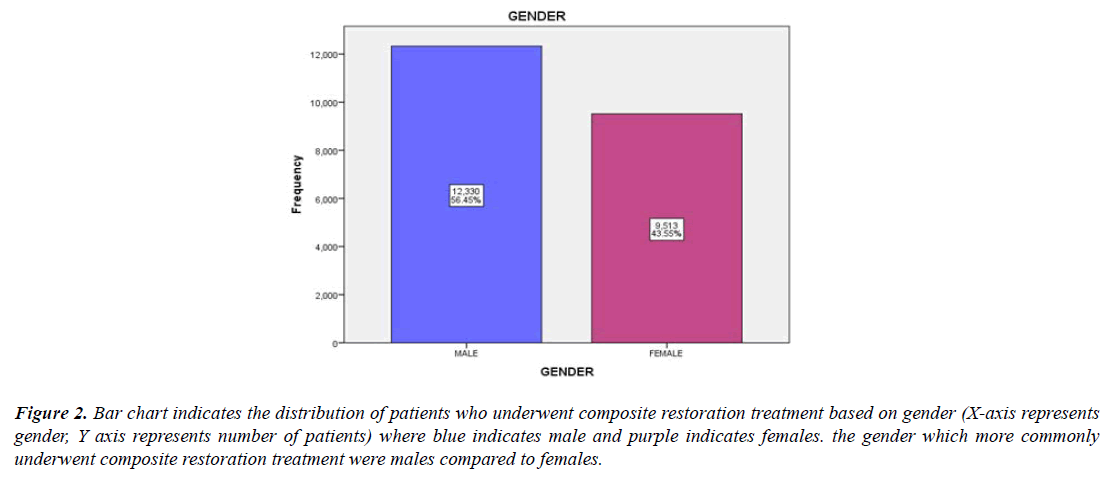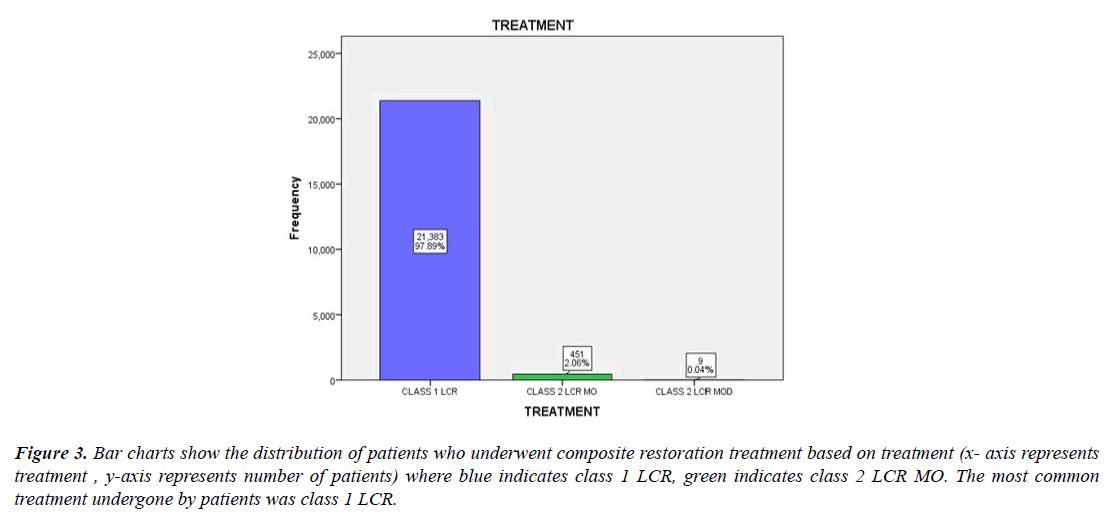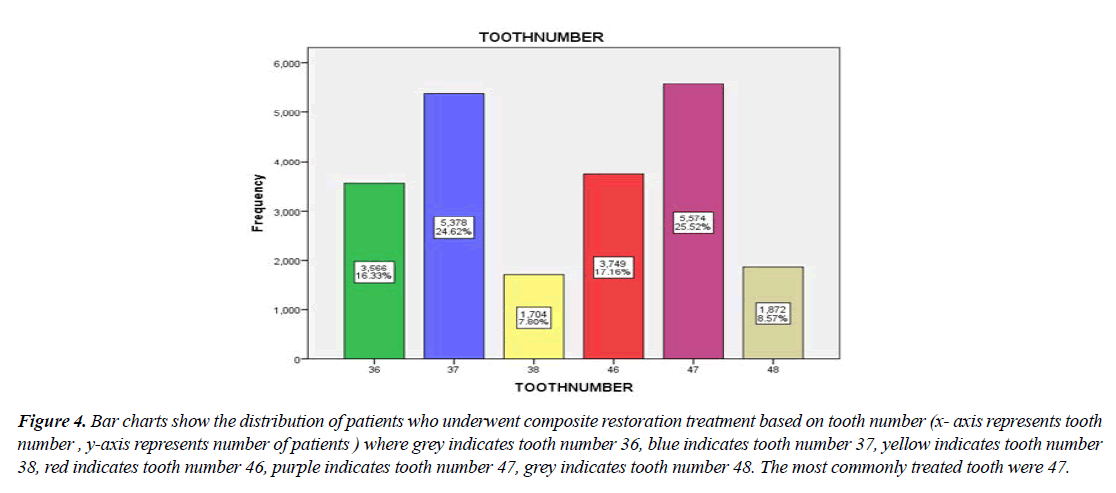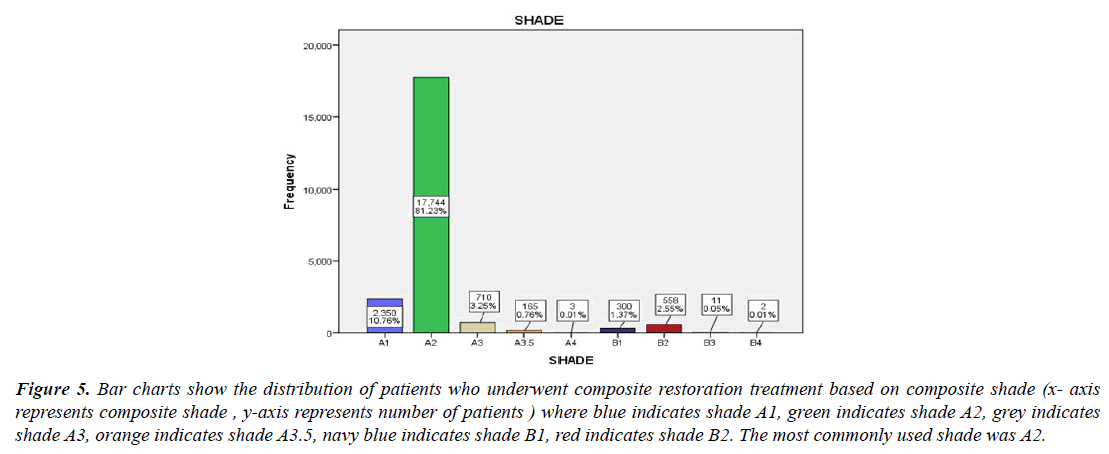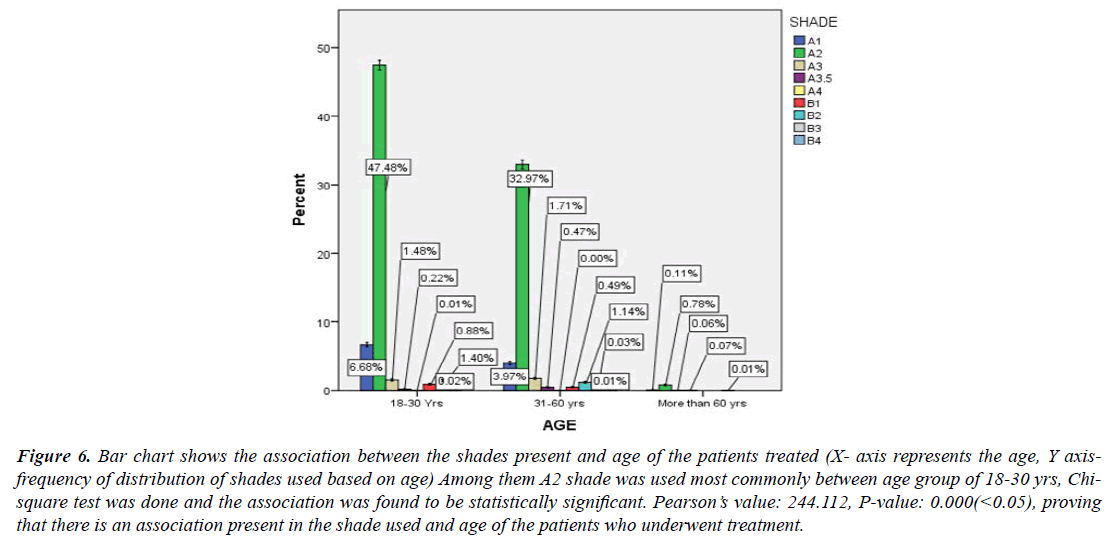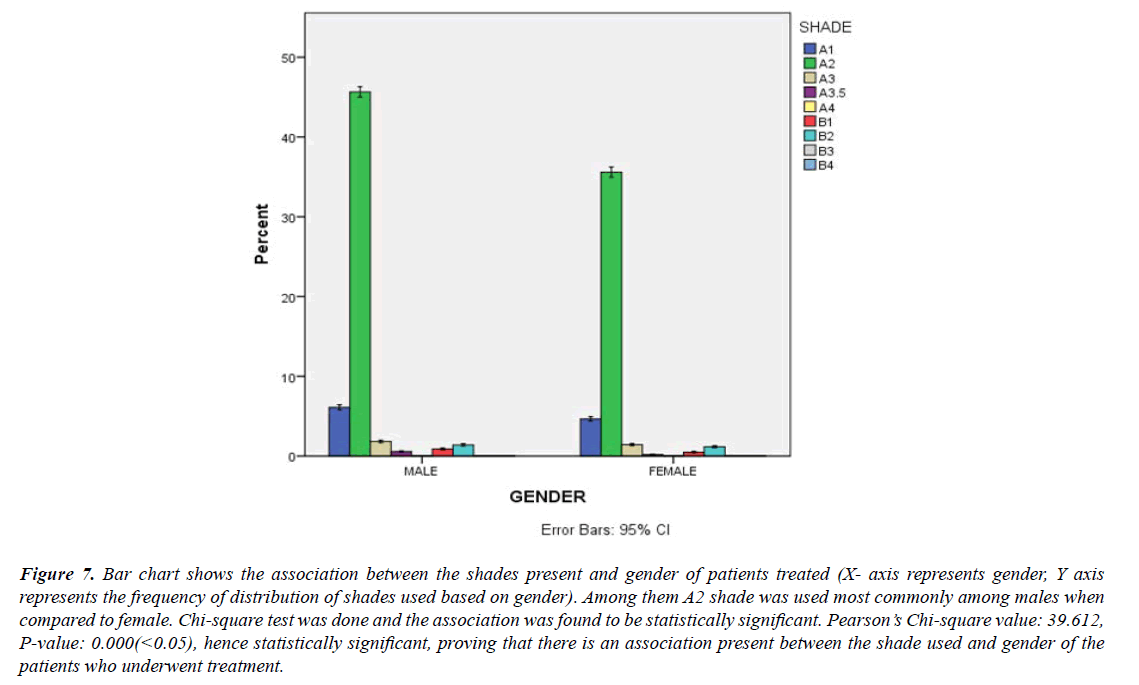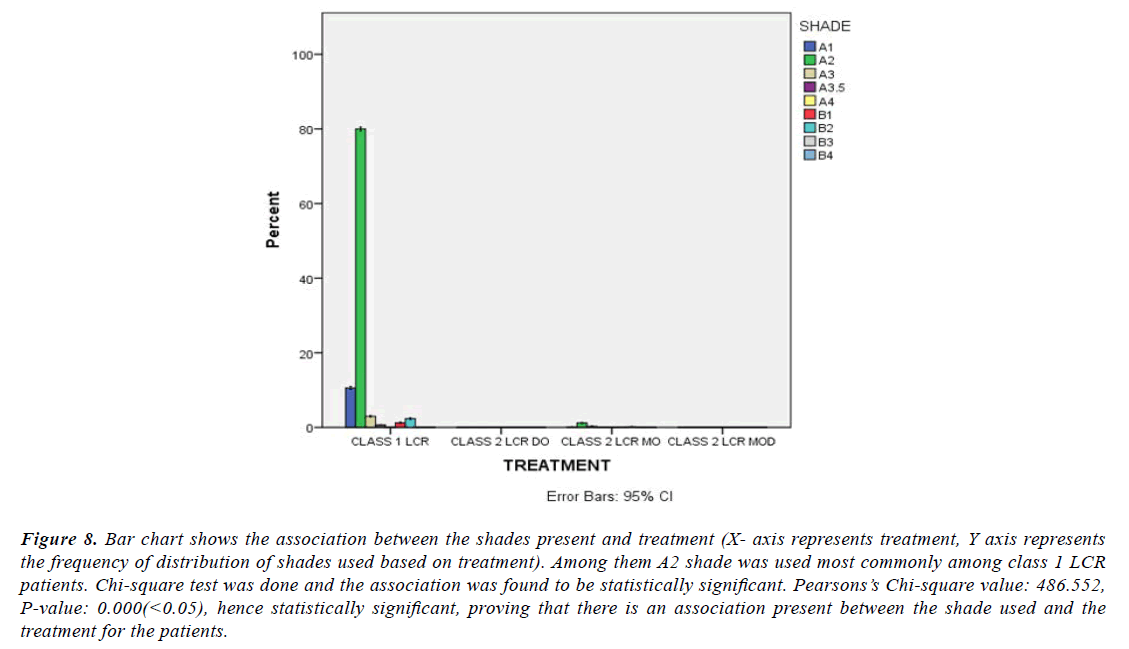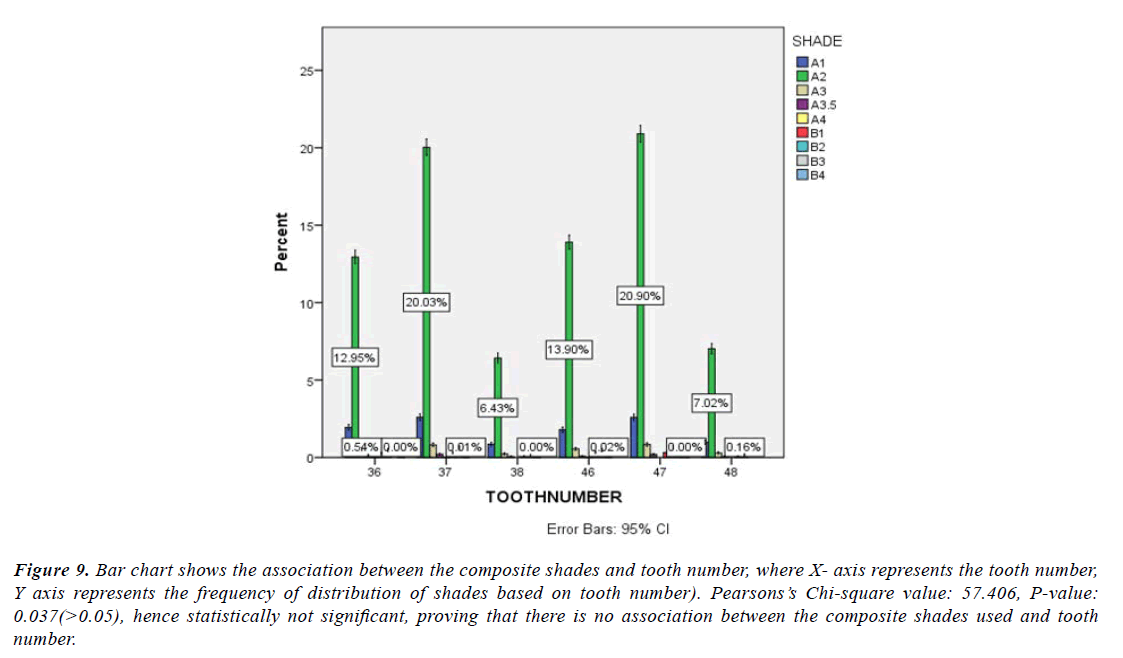Research Article - Journal of Clinical Dentistry and Oral Health (2023) Volume 7, Issue 1
Common Composites Shades Used For Restorations Of Mandibular Molar Teeth
Shalini Sathiyamoorthy, Vigneshwar T*Saveetha Dental College and Hospital, Saveetha Institute of Medical and Technical Science, Chennai, India
- *Corresponding Author:
- Vigneshwar T
Saveetha Dental College and Hospital
Saveetha Institute of Medical and Technical Science
Chennai, India
E-mail: vigneshwart.sdc@saveetha.com
Received: 19-Dec-2022, Manuscript No. AACDOH-22-84044; Editor assigned: 20-Dec-2022, PreQC No. AACDOH-22-84044 (PQ); Reviewed: 04-Jan-2023, QC No. AACDOH-22-84044 (QC); Revised: 09-Jan-2023, Manuscript No. AACDOH-22-84044(R); Published: 16-Jan-2023, DOI: 10.35841/aacdoh-7.1.134
Citation: Sathiyamoorthy S, Vigneshwar T. Common Composites Shades Used For Restorations Of Mandibular Molar Teeth. J Clinic Dent Oral Health. 2023;7(1):134
Abstract
Aim: The aim of the study is to determine the Common composite shades used for restoration of mandibular molar teeth. Introduction: Shade selection plays an important role to achieve with a good aesthetic restoration that harmoniously blends to the natural dentition. Even though the colour may not be important to the physiological success of a dental restoration, it plays a dominant role in patient acceptance. Patients are currently demanding esthetic replacement that must match their existing dentition, and are more concerned about the shade match of their restoration rather than the quality of the restoration. Material and Method: The retrospective study was conducted in a university setting. Data was collected from the patients who visited Saveetha dental college between June 2019 to February 2021. Among 21,843 patients who had reported to the department of conservative dentistry and endodontics of Saveetha dental college, prevalence of Common composite shades used for restoration of mandibular molar teeth was calculated. Result: It was noted that the most common age group to undergo treatment for composite restoration patients in the age group of 18-30 years (58.17%) (Figure 1).The most prevalent gender to undergo this treatment were Male (56.45%) (Figure 2). Most common treatment underwent by patients were class 1 LCR (97.89%) (Figure 3). Most prevalent teeth to be treated was Tooth number 47 (25.52%) (Figure 4). Most common shade used was A2 (81.23%) (Figure 5). Conclusion: Within the limitations of the study, it can be concluded the prevalence of Common composite shades used for restoration of mandibular molar teeth was most commonly seen in males than females. Significant association was present between the ages, gender with shade used.
Keywords
Shade selection, Aesthetic restoration, Mandibular molar.
Introduction
The demand for aesthetic, strength, life lasting and easy-touse dental restorative systems has led to the development of polymer-based dental composite materials [1,2]. At the present time, dental composites are widely used for filling the tooth cavities, veneering to mask discoloration, correcting contour, making dental implants and bonding orthodontic brackets [3,4]. Dental composite materials consist of a polymeric matrix and inorganic ceramic filler particles which are generally produced by light curing [5,6]. The polymeric matrix is flowable before curing, which makes the composite to fully penetrate into the tooth cavity [7,8]. During the curing procedure, the polymerization is activated, which allows the resin matrix to solidify and to change its mechanical properties rapidly and significantly [9,10]. Volumetric shrinkage also occurs in polymerization due to the decrease of intermolecular separations in the monomers of the polymeric matrix [11- 13]. In the restorative systems where the restorations are constrained along the interfaces, the polymerization shrinkage causes some shrinkage stresses in the composite and in the tooth [14-16]. In these cases, shrinkage stress may result in pulling the material away from the cavity walls which is the main reason for marginal debonding and then micro-leakage within the composite restorations [17,18]. Moreover, shrinkage forces on cusps produce cuspal deformation, enamel cracks and crazes which cause reduction in the fracture resistance of the cusp [19,21].
Shade selection plays an important role to achieve with a good aesthetic restoration that harmoniously blends to the natural dentition. Even though the colour may not be important to the physiological success of a dental restoration, it plays a dominant role in patient acceptance [22-25]. Patients are currently demanding esthetic replacement that must match their existing dentition, and are more concerned about the shade match of their restoration rather than the quality of the restoration. So chair side selection has become a very important step in the overall treatment of the patient. Both visual and instrumental methods are used for shade selection with merits and demerits over each other. However, the visual method is still the most commonly used method due to relative simplicity and low cost [26-28].
One of the main concerns in the visual method is its highly subjective nature. Different individuals can have different shade perceptions for the same object. To achieve a good result, the four basic determinants are required [29-32].They are position, contour, texture and colour. The knowledge of the concept of colour is of great importance to achieve a good esthetics and its distribution of colour is very essential for dental shade matching. Colour combination will make the restoration look natural and attractive and also gives a good esthetic result. Color is a result of the interaction of three dimensions known as hue, chroma and value [33-35]. Hue denotes qualities that can be differentiated by colour words such as red, yellow, green, blue or purple. Chroma is a degree of saturation or the intensity of the hue such as light blue, dark blue and royal blue. Value describes the relative brightness of colours [36-38]. Visual colour matching is affected by many variables, such as age of the observer, his/her experience, possible colour deficiency, condition of the teeth observed and the light source. Factors influencing the tooth colour may include congenital, metabolic, chemical, genetic, infectious and environmental [39-41]. The shade and appearance of teeth is a heterogeneous phenomenon because many factors like opacity, translucency, light scattering, lighting conditions, gloss and the human eye and the brain influence the overall perception of the tooth colour [42,43]. To ensure accuracy, various shade selection protocols have been devised and thorough knowledge of these protocols is important so that visual shade selections can be carried out with accuracy and precision. Increasingly composite are placed in preference due to patients' demands for esthetics as well as the clinical desire to do minimal preparation where possible and provide patients with bonded esthetic restoration [44,45].
Our team has extensive knowledge and research experience that has translated into high quality publications [3,8,10,18,46– 53]. The aim of the study is to find the prevalence of Common composite shades used for restoration of mandibular molar teeth.
Materials and Methods
Study Design and Setting
The retrospective study was conducted in a university hospital setting and the available data with similar ethnicity was collected from a particular geographic location. The trends in other locations were not assessed in this study setting. Ethical approval was given by the institutional ethical committee. The retrospective study was conducted in a university setting. Data was collected from the patients who visited Saveetha dental college between June 2019 to February 2021. Among 21,843 patients who had reported to the department of conservative and endodontics of Saveetha Dental College, prevalence of Common composite shades used for restoration of mandibular molar teeth were collected. From this data age, gender, type of shade, tooth number, treatment was recorded. Case sheets were reviewed and cross verification was done by another examiner to avoid errors.
Statistical analysis
Data was recorded in Microsoft Excel (version 2007, office 365) and later exported to IBM SPSS (version 20.0 Chicago USA) and subjected to Statistical analysis. Chi Square test was then employed with a level of significance set at P<0.05. Chi square test was done to compare the parameters. The outcome was represented in a form of tables and bar charts.
Results
It was noted that the most common age group to undergo treatment for composite restoration patients in the age group of 18-30 years (58.17%) (Figure 1) .The most prevalent gender to undergo this treatment were Male (56.45%) (Figure 2). Most common treatment underwent by patients were class 1 LCR (97.89%) (Figure 3). Most prevalent teeth to be treated was Tooth number 47 (25.52%) (Figure 4). Most common shade used was A2 (81.23%) (Figure 5). Correlation between the patient age and the shade used were statistically significant (p=0.000) (Figure 6) correlation between gender and the shade used were –statistically significant (p=0.000) (Figure 7). Correlation between treatment and shade used were - statistically significant (p=0.0000) (Figure 8). Correlation between the tooth number and the shade used-not statistically significant (p=0.037) (Figure 9).
Figure 1: Bar charts show the distribution of patients who underwent composite restoration treatment based on age (x- axis represents age group, y-axis represents number of patients) where grey indicates age group 18-30 years, green indicates 31-60 years, blue indicates more than years. The most common age group to undergo treatment for composite restoration were patients belonging the age group of 18-30 years.
Figure 2: Bar chart indicates the distribution of patients who underwent composite restoration treatment based on gender (X-axis represents gender, Y axis represents number of patients) where blue indicates male and purple indicates females. the gender which more commonly underwent composite restoration treatment were males compared to females.
Figure 3: Bar charts show the distribution of patients who underwent composite restoration treatment based on treatment (x- axis represents treatment , y-axis represents number of patients) where blue indicates class 1 LCR, green indicates class 2 LCR MO. The most common treatment undergone by patients was class 1 LCR.
Figure 4: Bar charts show the distribution of patients who underwent composite restoration treatment based on tooth number (x- axis represents tooth number , y-axis represents number of patients ) where grey indicates tooth number 36, blue indicates tooth number 37, yellow indicates tooth number 38, red indicates tooth number 46, purple indicates tooth number 47, grey indicates tooth number 48. The most commonly treated tooth were 47.
Figure 5: Bar charts show the distribution of patients who underwent composite restoration treatment based on composite shade (x- axis represents composite shade , y-axis represents number of patients ) where blue indicates shade A1, green indicates shade A2, grey indicates shade A3, orange indicates shade A3.5, navy blue indicates shade B1, red indicates shade B2. The most commonly used shade was A2.
Figure 6: Bar chart shows the association between the shades present and age of the patients treated (X- axis represents the age, Y axisfrequency of distribution of shades used based on age) Among them A2 shade was used most commonly between age group of 18-30 yrs, Chisquare test was done and the association was found to be statistically significant. Pearson’s value: 244.112, P-value: 0.000(<0.05), proving that there is an association present in the shade used and age of the patients who underwent treatment.
Figure 7: Bar chart shows the association between the shades present and gender of patients treated (X- axis represents gender, Y axis represents the frequency of distribution of shades used based on gender). Among them A2 shade was used most commonly among males when compared to female. Chi-square test was done and the association was found to be statistically significant. Pearson’s Chi-square value: 39.612, P-value: 0.000(<0.05), hence statistically significant, proving that there is an association present between the shade used and gender of the patients who underwent treatment.
Figure 8: Bar chart shows the association between the shades present and treatment (X- axis represents treatment, Y axis represents the frequency of distribution of shades used based on treatment). Among them A2 shade was used most commonly among class 1 LCR patients. Chi-square test was done and the association was found to be statistically significant. Pearsons’s Chi-square value: 486.552, P-value: 0.000(<0.05), hence statistically significant, proving that there is an association present between the shade used and the treatment for the patients.
Figure 9: Bar chart shows the association between the composite shades and tooth number, where X- axis represents the tooth number, Y axis represents the frequency of distribution of shades based on tooth number). Pearsons’s Chi-square value: 57.406, P-value: 0.037(>0.05), hence statistically not significant, proving that there is no association between the composite shades used and tooth number.
Universal shade bulk fill resin-composite may represent a smart solution in color-matching if it blends with the adjacent tooth structure shade, beside its increased curing depth. This material is indicated for posterior fillings (classes I and II), not in anterior teeth (classes III and IV). In the latter case, the high translucency of this resin-composite would transmit the background color of the oral cavity [54]. The high level of difficulty faced can be due to the fact that shade selection is done visually and the visual method has several known disadvantages and inaccuracies. The deficiencies can be controlled by utilizing the instrumental method which provides scientifically accurate shade reading [7]. High tech gadgets like colorimeters and spectrophotometers are expensive and very difficult to operate in a clinical setup. This is the reason for the visual method to remain as the most commonly used method for tooth shade selection worldwide. In the study by Alruwaili, etal. [5] dental unit light was used more than the natural light to do shade selection. Studies by Sambandam, et al. [55] showed similar results to our study. Natural light was used more than the other sources of light. Northern daylight is considered a standard for judging good lighting. However, in everyday dental practice we can't rely on sunlight so color-corrected fluorescent lights with CRI of 90 or above are recommended. The use of incandescent bulbs and dental unit lights is not recommended because of a greater amount of light remittance [22].
Even in the study by Sambandham.et.al A2 shade was considered as the most commonly used shade. But in the study by Alruwaili, et al. [56] B1 shade was commonly used in practice. The variation in the results may be to different geographical areas and a completely different population. Shade guides are said to have some disadvantages. To avoid all those mistakes, a new shade guide Vita 3D Master has been developed using Munsell's terminology. It utilizes the colour perception concept with five levels of values and three levels of chroma and hue and has been proved to be more accurate than the other theories [57,58].
Conclusion
Within the limitations of the study, it can be concluded the prevalence of Common composite shades used for restoration of mandibular molar teeth was most commonly seen in males than females. Significant association was present between the ages, gender with shade used.
Conflict of Interest
None to declare.
Acknowledgements
I would like to show our gratitude to the Director of Academics, DR. Deepak Nallasamy Veeraiyan, Saveetha Institute of Medical and Technical Sciences, for sharing his pearls of wisdom with us during the course of this research, and we thank the reviewers for their so-called insights. We are also immensely grateful to the Department of Conservative Dentistry and Endodontics, Saveetha Dental College for their comments on an earlier version of the manuscript, although any errors are our own and should not tarnish the reputations of these esteemed persons.
Source of Funding
The present study was supported by the following agencies:
Saveetha Dental College, Saveetha Institute of Medical and Technical Science, India and Sarkav Healthcare services.
References
- Alruwaili MN, Alanazi AO, Albilasi RM, et al. Knowledge, attitude and practice of dental students, practitioners and specialist on composite shade matching in Al-jouf, KSA. Egypt J Hosp Med. 2018;72(2):4017-20.
- Muthukrishnan L. Imminent antimicrobial bioink deploying cellulose, alginate, EPS and synthetic polymers for 3D bioprinting of tissue constructs. Carbohydr Polym. 2021;260:117774.
- Pradeep Kumar AR, Shemesh H, Nivedhitha MS, et al. Diagnosis of vertical root fractures by cone-beam computed tomography in root-filled teeth with confirmation by direct visualization: A systematic review and meta-analysis. J Endod. 2021;47(8):1198–214.
- Awinashe VN, Dugad JA. Effect of light intensity on the shade selection in ceramic restorations–A survey. Int J Clin Dent. 2010;2(3):23-7.
- Azer SS, Rosenstiel SF, Seghi RR, et al. Effect of substrate shades on the color of ceramic laminate veneers. J Prosthet Dent. 2011;106(3):179-83.
- Chakraborty T, Jamal RF, Battineni G, et al. A review of prolonged post-COVID-19 symptoms and their implications on dental management. Int J Env Res Pub Hea. 2021;18(10):5131.
- Barna GJ, Taylor JW, King GE, et al. The influence of selected light intensities on color perception within the color range of natural teeth. J Prosthet Dent. 1981;46(4):450-3.
- Muthukrishnan L. Nanotechnology for cleaner leather production: A review. Environ Chem Lett. 2021;19(3):2527–49.
- Joiner A. Tooth colour: A review of the literature. J Dent. 2004;32:3-12.
- Teja KV, Ramesh S. Is a filled lateral canal-A sign of superiority? J Dent Sci. 2020;15(4):562.
- Khoo TS. A comparison between a photographic shade analysis system and conventional visual shade matching method. UI. 2015.
- An B, Bhandari AN, Bulbule NS, et al. Comparison of photographic and visual method for tooth shade selection using two shade guides: A clinical research to improve shade communication. Int J Cur Res Rev. 2021. p. 18–23.
- Narendran K, MS N, Sarvanan A. Synthesis, characterization, free radical scavenging and cytotoxic activities of phenylvilangin, a substituted dimer of embelin. Indian J Pharm Sci. 2020;82(5):909-12.
- Malli Sureshbabu N, Selvarasu K, Nandakumar M, et al. Concentrated growth factors as an ingenious biomaterial in regeneration of bony defects after periapical surgery: A report of two cases. Case Rep Dent. 2019;85(3):100-25.
- Govindaraju L, Neelakantan P, Gutmann JL. Effect of root canal irrigating solutions on the compressive strength of tricalcium silicate cements. Clin Oral Investig. 2017;21(2):567-71.
- Saad I, Salem S. Knowledge, awareness, and perception of dental students, interns, and freshly graduated dentists regarding dental implant complications in Saudi Arabia: A web-based anonymous survey. BMC Oral Health. 2021;21(1):1-2.
- Koishi M. Application of microcapsules on colour material. J Soc Col Mat. 1973;21(1)629–35.
- Sawant K, Pawar AM, Banga KS, et al. Dentinal microcracks after root canal instrumentation using instruments manufactured with different NiTi alloys and the SAF system: A systematic review. Adv Sci Inst Ser E Appl Sci.2021;11(11):4984.
- Nandakumar M, Nasim I. Comparative evaluation of grape seed and cranberry extracts in preventing enamel erosion: An optical emission spectrometric analysis. J Coun Dev. 2018;21(5):516.
- O'Brien WJ, Hemmendinger H, Boenke KM, et al. Color distribution of three regions of extracted human teeth. Dent Mater J. 1997;13(3):179-85.
- Bhavikatti SK, Karobari MI, Zainuddin SL, et al. Investigating the antioxidant and cytocompatibility of Mimusops elengi Linn extract over human gingival fibroblast cells. Int J Env Res Pub Hea. 2021;18(13):7162.
- Rajakeerthi R, Nivedhitha MS. Natural product as the storage medium for an avulsed tooth–A systematic review. Cum Den J. 2019;22(2):249-56.
- Karobari MI, Basheer SN, Sayed FR, et al. An In vitro stereomicroscopic evaluation of bioactivity between Neo MTA Plus, Pro Root MTA, BIODENTINE & glass ionomer cement using dye penetration method. Mat. 2021;14(12):3159.
- Ramarao S, Sathyanarayanan U. CRA Grid-A preliminary development and calibration of a paper-based objectivization of caries risk assessment in undergraduate dental education. J Conserv Dent.2019;22(2):185.
- Banerji S, Mehta SB. Repair and refurbishment of resin composite restorations. Pra Pro Aes Den. 2017;(2): 141-143.
- Vichi A, Ferrari M, Davidson CL. Influence of ceramic and cement thickness on the masking of various types of opaque posts. J Prosthet Dent. 2000;83(4):412-7.
- Rohit Singh T, Ezhilarasan D. Ethanolic extract of Lagerstroemia speciosa (L.) Pers. induces apoptosis and cell cycle arrest in HepG2 cells. Nutr Cancer. 2020;72(1):146-56.
- Ezhilarasan D. MicroRNA interplay between hepatic stellate cell quiescence and activation. Eur J Pharmacol. 2020;885:173507.
- Jathmi AA, Alqahtani MA, Hussain MW. Evaluation of accuracy of shade selection ability of students in the dental clinics and duplication of selected shade by the dental laboratory. A spectrophotometric in-vivo study. Saudi Dent J . 2019;31:S77.
- Yuan JC, Brewer JD, Monaco Jr EA, et al. Defining a natural tooth color space based on a 3-dimensional shade system. J Prosthet Dent. 2007;98(2):110-9.
- Paravina RD, Westland S, Kimura M, Powers JM, Imai FH. Color interaction of dental materials: Blending effect of layered composites. Den Mat. 2006;22(10):903-8.
- Romera A, Peredpaya S, Shparyk Y, et al. Bevacizumab biosimilar BEVZ92 versus reference bevacizumab in combination with FOLFOX or FOLFIRI as first-line treatment for metastatic colorectal cancer: A multicentre, open-label, randomised controlled trial. Lan Gastro Hep. 2018;3(12):845-55.
- Paravina RD, Westland S, Imai FH, et al. Evaluation of blending effect of composites related to restoration size. Den Mat. 2006;22(4):299-307.
- Lassila L, Keulemans F, Säilynoja E, et al. Mechanical properties and fracture behavior of flowable fiber reinforced composite restorations. Den Mat. 2018;34(4):598-606.
- Raj RK, DE, SR. β-Sitosterol-assisted silver nanoparticles activates Nrf2 and triggers mitochondrial apoptosis via oxidative stress in human hepatocellular cancer cell line. J Biomed Mater Res A. 2020;108(9):1899–908.
- Colucci V, Dos Santos CD, Amaral FL, et al. Influence of NaHCO3 powder on translucency of microfilled composite resin immersed in different mouthrinses. J Esthet Restor Dent. 2009;21(4):242-8.
- Ma T, Johnston WM, Koran A. The color accuracy of the Kubelka-Munk theory for various colorants in maxillofacial prosthetic material. J Dent Res.1987;66(9):1438-44.
- Vijayashree Priyadharsini J. In silico validation of the non-antibiotic drugs acetaminophen and ibuprofen as antibacterial agents against red complex pathogens. J Periodontol. 2019;90(12):1441-8.
- Fach C, Sharpe LT. Assimilative hue shifts in color depend on bar width. Per Psy. 1986 ;40(6):412-8.
- McCamy CS. Colors of some small figures on colored grounds. Color research & application: Endorsed by inter society color council, the colour group (Great Britain), Canadian Society for Color, Color Science Association of Japan, Dutch Society for the Study of Color. 2003;28(4):242-50.
- Priyadharsini JV, Girija AS, Paramasivam A. In silico analysis of virulence genes in an emerging dental pathogen A. baumannii and related species. Arch Oral Biol. 2018;94:93-8.
- Uma Maheswari TN, Nivedhitha MS, Ramani P. Expression profile of salivary micro RNA-21 and 31 in oral potentially malignant disorders. Braz Oral Res. 2020;34:e002.
- Gudipaneni RK, Alam MK, Patil SR, et al. Measurement of the maximum occlusal bite force and its relation to the caries spectrum of first permanent molars in early permanent dentition. J Clin Pediatr Dent. 2020;44(6):423–8.
- Chaturvedula BB, Muthukrishnan A, Bhuvaraghan A, et al. Dens invaginatus: A review and orthodontic implications. Br Dent J. 2021;230(6):345–50.
- Kanniah P, Radhamani J, Chelliah P, et al. Green synthesis of multifaceted silver nanoparticles using the flower extract of Aerva lanata and evaluation of its biological and environmental applications. Chem Sel. 2020;5(7):2322–31.
- Muthukrishnan L. Imminent antimicrobial bioink deploying cellulose, alginate, EPS and synthetic polymers for 3D bioprinting of tissue constructs. Carbohydr Polym. 2021;260:117774.
- Chakraborty T, Jamal RF, Battineni G, et al. A review of prolonged Post-COVID-19 symptoms and their implications on dental management. Int J Env Res Publ Hea. 2021 ;18(10):5131.
- Narendran K, MS N, Sarvanan A. Synthesis, characterization, free radical scavenging and cytotoxic activities of phenylvilangin, a substituted dimer of embelin. Indian J Pharm Sci. 2020 ;82(5):909-12.
- Reddy P, Krithikadatta J, Srinivasan V, et al. Dental caries profile and associated risk factors among adolescent school children in an Urban South-Indian City. Oral Health Prev Dent. 2020;18(1):379–86.
- Bhavikatti SK, Karobari MI, Zainuddin SLA, et al. Investigating the antioxidant and cytocompatibility of Mimusops elengi Linn extract over human gingival fibroblast cells. Int J Environ Res Public Health. 2021;18(13).
- Karobari MI, Basheer SN, Sayed FR, et al. An In Vitro stereomicroscopic evaluation of bioactivity between Neo MTA Plus, Pro Root MTA, BIODENTINE & glass ionomer cement using dye penetration method. Mat. 2021;14(12).
- Vijayashree Priyadharsini J. In silico validation of the non-antibiotic drugs acetaminophen and ibuprofen as antibacterial agents against red complex pathogens. J Periodontol. 2019;90(12):1441–8.
- Priyadharsini JV, Girija AS, Paramasivam A. In silico analysis of virulence genes in an emerging dental pathogen A. baumannii and related species. Arch Oral Biol. 2018;94:93-8.
- Awinashe VN, Dugad JA. Effect of light intensity on the shade selection in ceramic restorations–A survey. Int. J Clin Dent. 2010;2(3):23-7.
- Abdullah D, Soo SY, Kanagasingam S. Knowledge of managing avulsed tooth among general dental practitioners in Malaysia. Singap Dent J. 2016;37:21-6.
- Alruwaili IA, Almazyad AB, Basri R, et al. Knowledge, awareness, and attitude of the health care students towards epilepsy in Jouf University. Int J Med Develop Countries. 2019;3:1037-42.
- Brewer JD, Wee A, Seghi R. Advances in color matching. Den Cli. 2004;48(2):341-58.
- Paravina RD, Powers JM. Esthetic Color Training in Dentistry. Mosby; 2004. 245 p.
Indexed at, Google Scholar, Cross Ref
Indexed at, Google Scholar, Cross Ref
Indexed at, Google Scholar, Cross Ref
Indexed at, Google Scholar, Cross Ref
Indexed at, Google Scholar, Cross Ref
Indexed at, Google Scholar, Cross Ref
Indexed at, Google Scholar, Cross Ref
Indexed at, Google Scholar, Cross Ref
Indexed at, Google Scholar, Cross Ref
Indexed at, Google Scholar, Cross Ref
Indexed at, Google Scholar, Cross Ref
Indexed at, Google Scholar, Cross Ref
Indexed at, Google Scholar, Cross Ref
Indexed at, Google Scholar, Cross Ref
Indexed at, Google Scholar, Cross Ref
Indexed at, Google Scholar, Cross Ref
Indexed at, Google Scholar, Cross Ref
Indexed at, Google Scholar, Cross Ref
Indexed at, Google Scholar, Cross Ref
Indexed at, Google Scholar, Cross Ref
Indexed at, Google Scholar, Cross Ref
Indexed at, Google Scholar, Cross Ref
Indexed at, Google Scholar, Cross Ref
Indexed at, Google Scholar, Cross Ref
Indexed at, Google Scholar, Cross Ref
Indexed at, Google Scholar, Cross Ref
Indexed at, Google Scholar, Cross Ref
Indexed at, Google Scholar, Cross Ref
Indexed at, Google Scholar, Cross Ref
Indexed at, Google Scholar, Cross Ref
Indexed at, Google Scholar, Cross Ref
Indexed at, Google Scholar, Cross Ref
Indexed at, Google Scholar, Cross Ref
Indexed at, Google Scholar, Cross Ref
Indexed at, Google Scholar, Cross Ref
Indexed at, Google Scholar, Cross Ref
Indexed at, Google Scholar, Cross Ref
Indexed at, Google Scholar, Cross Ref
Indexed at, Google Scholar, Cross Ref
Indexed at, Google Scholar, Cross Ref
Indexed at, Google Scholar, Cross Ref
Indexed at, Google Scholar, Cross Ref
Indexed at, Google Scholar, Cross Ref
Indexed at, Google Scholar, Cross Ref
Indexed at, Google Scholar, Cross Ref
Indexed at, Google Scholar, Cross Ref
Indexed at, Google Scholar, Cross Ref
Indexed at, Google Scholar, Cross Ref
Indexed at, Google Scholar, Cross Ref
Indexed at, Google Scholar, Cross Ref
Indexed at, Google Scholar, Cross Ref
Indexed at, Google Scholar, Cross Ref
Indexed at, Google Scholar, Cross Ref
